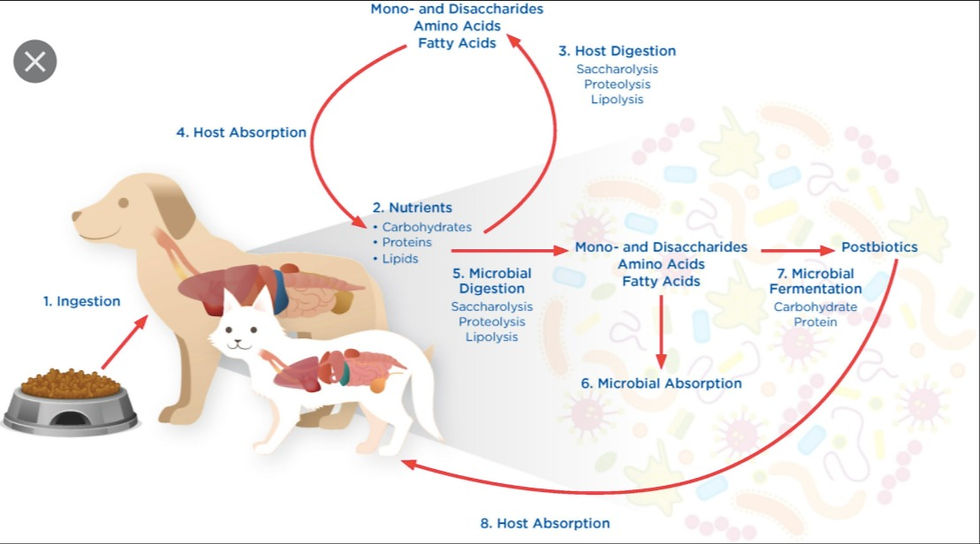How to Maintain a Healthy Diet in Dogs
- Kay Nagasato
- Oct 9, 2020
- 4 min read
Updated: Mar 31, 2022

The gastrointestinal (GI) microbiome is extremely important for an animal’s metabolism. The microbiome refers to the trillions of microbes residing in the digestive tract, and a balanced microbiome helps your pet maintain a healthy weight, absorb nutrients, improve mood, maintain healthy skin and fur, live longer, and build up a strong immune system. Because the microbiome has such profound and wide-ranging effects on health, it has recently begun to be classified as an organ. Diet, medications, and environment most notably influence the microbiome, and imbalance can lead to chronic diarrhea, vomiting, skin conditions, and various diseases. This post will specifically focus on the role that food plays in defining the GI microbiome.

The GI microbiome breaks down food and produces metabolites like vitamins, nutrients, and short chain fatty acids. The microbes release these metabolites into the body to influence the immune system and inflammatory functions. Evidence has also suggested that the GI microbiome plays a role in the development and regulation of the nervous, renal, digestive, dermal, endocrine, immune, and respiratory systems.
Unlike humans, dogs and cats don’t rely on their microbiome for energy, mainly because cats don’t require large amounts of glucose and dogs can metabolize large amounts of carbohydrates. With a few differences, the composition of the microbiome in cats and dogs is relatively similar.

When we think of dog food, the first thought that comes to mind is the dry, brown kibble that comes in bulk bags. These are formulated to contain the typical nutritional macromolecules of carbohydrates, proteins, and fats, and sometimes even microbiome-targeted ingredients like prebiotics and probiotics. But is this food enough to appropriately nourish an animal?
To test the impact of carbohydrates, proteins, fibers, and fats on intestinal microbiota, a recent study evaluated the differences between 6 dogs who were given various prescription diets. Each dog was fed one of the four different prescribed diets, each for 21 days: a weight-loss diet (high protein and fiber, low carbohydrates and fat), a low-fat diet (high carbohydrates, medium protein, low fat and fiber), a renal diet (high fat and carbohydrate, low protein and fiber), and an allergenic diet (high fat, medium carbohydrate, low fiber, medium hydrolyzed protein). It was found that there were significant differences between the dogs who were fed the weight-loss diet and the allergenic diet. Because the weight-loss and allergenic diet had drastically different macromolecule compositions, we can conclude that diet has a significant impact on microbiome health.

So how exactly do we improve our pet’s microbiome balance? There is no definite answer, because every animal is different. However, the following section will summarize the impact of several different common nutritional interventions with the aim to improve microbiome health.
One of the most common approaches is the use of probiotics, which have been defined as live organisms. Probiotics can stimulate the growth of resident bacteria, alter the abundance of pathogenic bacteria, and indirectly interact with the epithelial immune system. However, because much about probiotics remains unknown, there are many safety and health concerns to consider before using them.
Complex carbohydrates, such as oligosaccharides and polysaccharides, are most commonly used in pet food in the form of fiber. The impact of various types of complex carbohydrates have been studied in cats and dogs. For example, studies of resistant starches showed that increasing concentrations of potato fiber increased the amount of Faecalibacterium in the microbiome. Fructooligosaccharides have been shown to increase the potentially beneficial Lactobacillus and Bifidobacterium populations while reducing potentially harmful C. perfringens populations. Simple carbohydrates, like monosaccharides and disaccharides, can also alter microbiome composition. Rats who were exposed to sugar early in life displayed reduced populations of Prevotella and Lachnospiraceae incertae sedis but increased populations of Bacteroides, Alistipes, Lactobacillus, Clostridium sensu stricto, Bifidobacteriaceae, and Parasutterella, but whether or not these changes also occur in dogs and cats remains unknown.
Most pet foods use animal protein sources because they are more rich in amino acids. In order to be absorbed by animals, dietary protein must undergo proteolysis, which is the break down of proteins into amino acids. Studies have failed to show that hydrolyzed protein food impacts microbiome composition, therefore the effects of protein on dogs is not well understood. Raw meat-based diets have become increasingly popular, despite not being recommended by most major veterinary and public health organizations. These are high protein diets that include skeletal muscle, fat, internal organs, cartilage, bones, and more. Several studies have shown that dogs who were fed these diets exhibited more diverse and abundant microbe populations compared to those who were fed heat-processed foods, however, raw meat diets have a high risk of infection.
In conclusion, a pet’s microbiome is very complex and sophisticated, making it difficult to understand what types of foods are most beneficial to their health. There have been many studies that have shown that raw meat or vegetables can be beneficial to an animal’s health, so this is definitely something that an owner could add to their pet’s diet (with veterinarian approval, of course). However, if you don’t feel comfortable giving these foods to your pet, a kibble diet is perfectly acceptable as well, as these foods are formulated to give your dog all the nutrients they need.
Bibliography
“About Your Pet’s Microbiome.” n.d. AnimalBiome. Accessed September 28, 2020. https://www.animalbiome.com/about-your-companions-microbiome.
Becker, Karen Shaw. 2018. “Your Dog’s Microbiome.” Animal Wellness. November 22, 2018. https://animalwellnessmagazine.com/your-dogs-microbiome/.
Wernimont, Susan M., Jennifer Radosevich, Matthew I. Jackson, Eden Ephraim, Dayakar V. Badri, Jennifer M. MacLeay, Dennis E. Jewell, and Jan S. Suchodolski. 2020. “The Effects of Nutrition on the Gastrointestinal Microbiome of Cats and Dogs: Impact on Health and Disease.” Frontiers in Microbiology 11 (June): 1266.
“ゲインズパックン ビーフ・緑黄色野菜・小魚・チーズ入り 2.5kg 【ゲインズパックン ドッグフード/ドライフード/愛犬用/ペットフード/DOG FOOD/ドックフード】【犬のご飯・犬のごはん】【犬のえさ・犬のエサ・犬の餌】【ユニチャーム Unicharm】.” n.d. Lohaco. Accessed September 28, 2020. https://lohaco.jp/product/L08966800/.
%20copy.png)



Comments